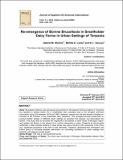| dc.contributor.author | Shirima, Gabriel | |
| dc.contributor.author | Lyimo, Bertilla | |
| dc.contributor.author | Kanuya, N. L. | |
| dc.date.accessioned | 2019-05-24T05:48:57Z | |
| dc.date.available | 2019-05-24T05:48:57Z | |
| dc.date.issued | 2018-04-30 | |
| dc.identifier.issn | 2394-1103 | |
| dc.identifier.uri | DOI: 10.9734/JALSI/2018/40955 | |
| dc.identifier.uri | http://dspace.nm-aist.ac.tz/handle/123456789/185 | |
| dc.description | Research Article published by Journal of Applied Life Sciences International | en_US |
| dc.description.abstract | Aims: Brucellosis infection was previously encountered in all livestock farming systems in Tanzania
but reported to decline below 2% in smallholder dairy subsector due to the stringent calf-hood
vaccination using S19 between 1979 and 1990. However, reports from the last decade indicated an
increase of the infection in the smallholder dairy subsector. This prompted several researchers to
conduct further studies in different urban settings to ascertain the disease and associated risk
factors. This study aims to elucidate the magnitude of brucellosis in urban areas of Morogoro region
and related risk factors in the advent of no control intervention in place. Presence of anti-brucella
antibodies in dairy animals residing in urban areas may pose a threat to milk consumers in the cities
as a significant proportion of the milk is sold informally. Therefore, generating this information will
inform policy to formulate feasible intervention for controlling brucellosis in urban settings that
indirectly will safeguard public health.
Study Design: This was a cross-sectional survey.
Place and Duration of Study: The study was conducted in Morogoro Municipality between May
and September 2012.
Methodology: The study was to determine the prevalence of anti-brucella antibodies in smallholder
dairy cattle in urban settings of Tanzania. Milk Ring Test was used as a screening technique while
Competitive Enzyme-Linked Immunosorbent Assay was a confirmatory test. A questionnaire was
applied to each animal owner. A total of 104 respondents were interviewed to assess possible risk
factors associated with re-emergence and transmission of brucellosis among dairy cattle.
Results: 390 dairy cows from Morogoro Municipality were screened for Brucella circulating
antibodies. Overall 35.4% (95%CI; 25.2-33.8) of milk samples tested positive based on MRT while
seroprevalence was 21.3% (95% CI) based on c-ELISA. It was further revealed that abortion (p=
0.01) and herd size (0.05) were significantly associated with brucellosis seropositivity in cattle.
Although 32% of herd owners vaccinate their cattle against several transboundary diseases, none
vaccinated against brucellosis.
Conclusions: From this study, there is evidence that collapse of the Tuberculosis and Brucellosis
Control Programme has resulted into an increase of brucellosis within the smallholder dairy farmers
within urban settings. This may pose a high risk to urban farmers and milk consumers thus attracting
immediate response. | en_US |
| dc.language.iso | en_US | en_US |
| dc.publisher | Journal of Applied Life Sciences International | en_US |
| dc.subject | Farming systems | en_US |
| dc.subject | urban brucellosis | en_US |
| dc.title | Re-emergence of Bovine Brucellosis in Smallholder Dairy Farms in Urban Settings of Tanzania | en_US |
| dc.type | Article | en_US |

